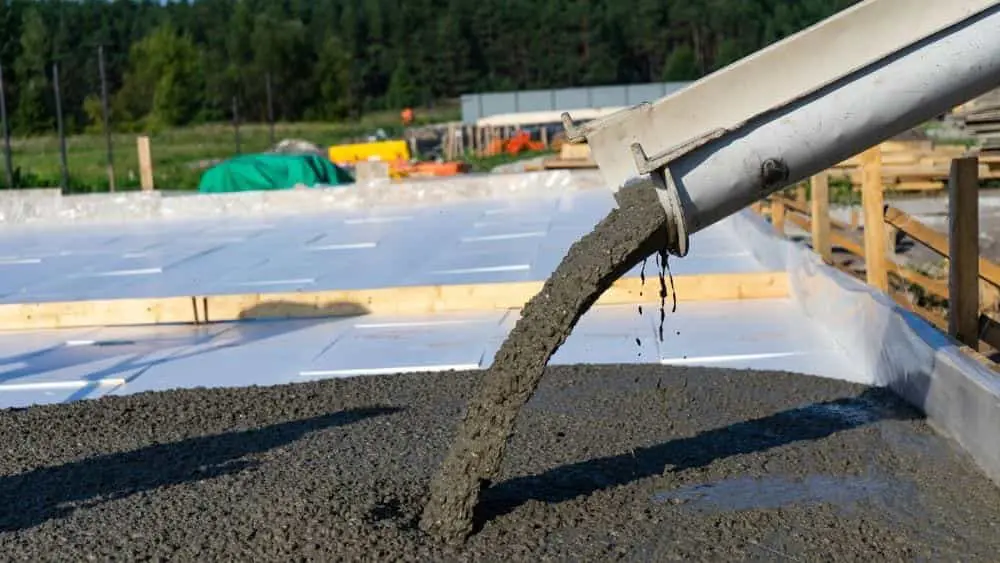What you need to know about how your builder is building a solid foundation for your new home.

Footings and foundations are to homes what feet and legs are to the human body: footings anchor the home to the ground and support the foundation, which in turn carries the weight of the home.
Although foundations have been made from a number of materials — stone, block and even treated wood — reinforced concrete is used in the vast majority of new homes. The contractor erects wooden forms, installs steel reinforcing bars (“rebar”) between the form faces, then fills the forms with poured concrete. After the concrete sets, the forms are removed.
There are three main foundation types: full basement, crawlspace and slab-on grade. Different types are popular in different parts of the country, with reasons that include ground conditions and local market expectations.
Full Basements
Although full basements can be found in many areas, homeowners in the Northeast tend to expect them. A full basement typically consists of footings placed deep below the region’s frost depth and eight-foot-high walls that enclose a four-inch-thick poured concrete slab. This creates an underground room that can be used as a storage and mechanical space and/or finished to create a living area.
Basement finishing is a growing trend:
Homeowners are turning these spaces into recreational rooms, gyms, and entertainment centers. If the lot slopes or allows for a walkout configuration, the basement will have natural light, good ventilation and a more spacious feel. If you think you might want to put a toilet in the basement, consider including a well for a grinder pump.
If you plan on finishing the basement, you may want to consider installing rigid foam insulation beneath the slab. While it may not noticeably lower energy use, it could make the space more comfortable.
Even when not finishing the basement, insulating the slab and walls can reduce problems with mold and mildew, since the insulation reduces the chance of condensation by keeping the concrete at a higher temperature.
Basements with insulation under the slab “don’t smell like basements and feel clean and dry,” says Portland, Maine, architect Jesse Kaplan. “It’s a tremendous improvement over what people are used to. Honestly, I would never build a house without insulation and a vapor barrier between wet soil and concrete for the quality and comfort issues alone.”
He says that under-slab insulation isn’t just for the far North. “Soil temperatures down South are warmer than in the Northeast, but they’re probably below the dew point even more of the year, so the dampness is even more of an issue.”
Crawlspaces
Crawlspaces are most common in the Southeast and parts of the Midwest. The footings are placed below the frost line, but there’s only enough headroom between the ground and the floor frame for someone to crawl around.
Most crawl spaces include foundation vent openings. They’re supposed to prevent the buildup of excess moisture, but in practice they often backfire by bringing moisture into the space. “Open crawlspaces can become breeding grounds for mold and moisture,” says Brian Coble, who directs the High Performance Homes program at Advanced Energy, a North Carolina building science research firm. “This moisture can soak the home’s framing, leading to rot and structural failure, and can carry mold spores and other pollutants into the home’s living space.”
Building scientists like Coble now recommend sealing and insulating the crawlspace and covering the ground with a polyethylene vapor barrier, or even a concrete slab. These details add cost, but a multiple home field study (27 homes in different parts of the country) by Advanced Energy confirmed that they can also lower space conditioning bills and reduce mold and mildew. As a bonus, you end up with a tempered, dry storage space. If there’s enough headroom, the heating unit can also be placed there, freeing up space in the house.
Slab-on-Grade
The slab-on-grade foundation is just what it sounds like: A concrete slab poured at grade level that serves as the subfloor for the home’s main living area. A shallow footing around the edges of the slab transfers the weight of the home’s walls to the ground. Before the pour, a bed of gravel is spread across the slab area to allow drainage, wire mesh is rolled out to reduce the chance of cracking and any in-slab plumbing pipes or electrical conduit is installed.
Slab foundations are most common in warm regions and where there are high water tables, such as Florida. When used in northern climates, special frost proofing details are required, which, in most cases, consists of a short foundation wall (called a “stemwall”) poured on footings placed below the frost line. Putting a layer of rigid foam under the slab in a slab-on-grade home is also a good idea in the North and absolutely necessary if the slab will have embedded hydronic heat.
Note that using a foundation type that’s not common in your area may affect the schedule and budget. With a slab, for instance, the mechanical systems have to be completely figured out before the slab is poured, so that the proper elements are put in place. If that’s not standard practice where you live, subcontractors may raise prices to cover unexpected time and cost overruns.
Soil Considerations
Regardless of foundation type, the foundation walls and footing are designed to work as a unit, supporting the weight of the home and transferring that weight to the surrounding ground. How well they do this depends in part on what type of ground the footing rests on.
Foundations for commercial buildings are custom engineered for each site, but in residential construction that’s usually only true in special cases. “Almost all residential foundations are designed according to generic expectations of the area’s soil conditions,” says Atlanta-area structural engineer Chris DeBlois. “If the foundation crew starts digging and finds unusual conditions, then they will make adjustments.”
For instance, dense, dry soil will be stable, forgiving of less-than-perfect construction and less likely to settle after the house has been built. But if the site has soft, wet clay, the foundation will be much more likely to settle, leading to cracked tile, drywall and even masonry.
In that case, it’s a good idea to get an engineer involved to design a foundation that will remain stable.
Keeping it Dry
Concrete is not waterproof, so water that sits on the outside of the foundation wall will eventually make its way inside as water vapor.
“Surface water that seeps into the ground near the house will quickly become an interior moisture problem,” says Steve Easley, a San Francisco-area trainer who advises builders around the country on good building practices. The result: a damp home environment that encourages mold and mildew growth. This is true regardless of foundation type.
To prevent this, a waterproofing coating is usually brushed on the outside of the foundation. Perforated pipe may be placed around the perimeter of the footing to catch any water in the soil and drain it away. Note that most waterproofing coatings require a footing drain for the new home warranty to be valid.
Landscaping also plays an important role in keeping foundations dry. Easley recommends siting the house well enough above grade so that water can easily drain away from the foundation. Using firm, rather than loose, soil close to the house will also help.
Signs of Trouble
Small hairline shrinkage cracks aren’t unusual with a new foundation or of serious concern, but some other types of cracks should raise a red flag. “The size of the crack is less important than its configuration,” says DeBlois. “A narrow, vertical crack is seldom a sign of problems, but if the crack is significantly wider at the top than at the bottom, it could indicate that the foundation is settling unevenly.”
The most worrisome type of crack, according to DeBlois, is a horizontal one, which could indicate a structural failure of the wall. Fortunately, this type of failure is more common with block walls and is extremely rare with poured concrete.
Post-Tension Foundations
Post-tensioning, which must be accomplished at the building site, uses high-strength steel bands and bars to improve tension-handling ability to stabilize the structure. Not only does this this prevent the unpopular “settling” experience where homes creak and groan into position, but post-tension foundations are also a strong indicator of future structural integrity. This increases a home’s resale value, and for a lot of homeowners, is worth the investment.
Protect Yourself
It should be clear that while designing and building a stable, dry and trouble-free foundation for your home is a straightforward process, proper detailing is important. The best way to protect yourself and your home is to hire a well-reviewed builder with a long-standing reputation for quality work.
As an added precaution, you could hire an independent inspector to check the foundation before framing begins. This is only done in a minority of homes, but Jules Falcone, a Media, Penn.-based home inspector, says it is worthwhile. “An independent inspector will check the workmanship to make sure the foundation is built right.”
Falcone estimates cost at a couple hundred dollars, depending on where you live. That’s a small price to pay to ensure the job is done correctly.

Charlie Wardell is a licensed builder and a writer and editor with more than 20 years of experience covering home building and construction.
A Massachusetts resident, his work has appeared in some of the nation’s leading media brands in print and online.
In addition to his exclusive articles for NewHomeSource, Charlie has written or edited for publications that include Architectural Record, Custom Builder, Fine Homebuilding, Green Builder, Harvard Management Update, Popular Science and This Old House.
 New Home Construction: Loans and Financing
New Home Construction: Loans and Financing
Kathryn antonelli
Mr Wardell, I read your recent article on new home foundations. we built a new home in 2000. We were only in home 5 months and noticed slab sinking in back corner, Builder lived next door. We had him over and he said normal settling I think it is done. Well it wasn’t done. Sank more and more. We took him to court he had 3 lawyers to our one. We settled with enough to pay lawyer and first set of piers. They failed. Piered again several years later. Slabed jacked 3 times.
19 years later it is sinking again. My question is is it possible to have a company come in and shoot gravel under house to bring it up to fill void under house. The guy that put in piers said there was nothing under house, empty space. Thank you for any insight. We have also put in 2 sets of drains to keep water away from house. There is also a berm in back of house.